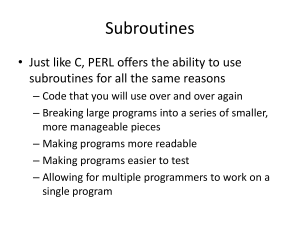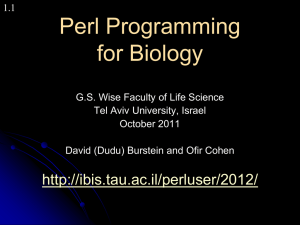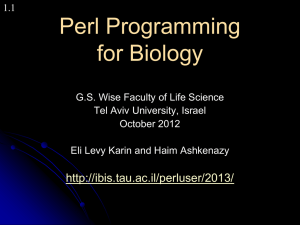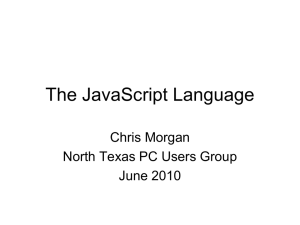Basic Perl Programming
advertisement
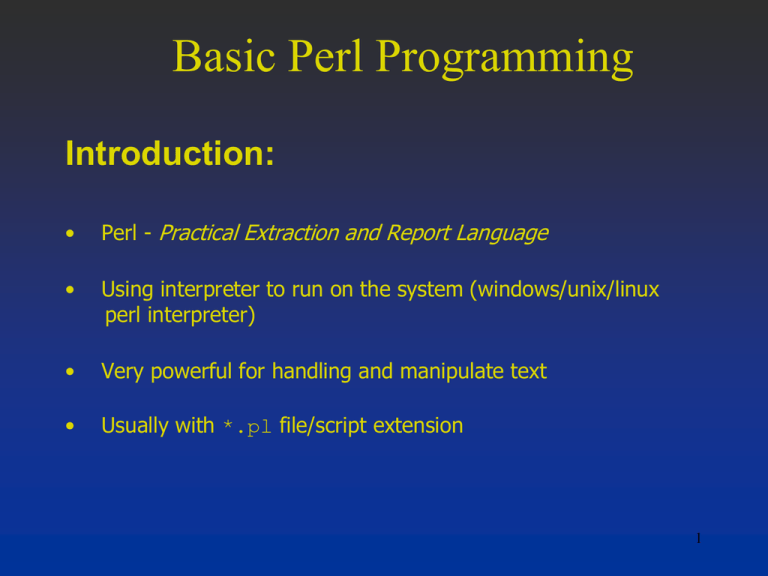
Basic Perl Programming
Introduction:
•
Perl - Practical Extraction and Report Language
•
Using interpreter to run on the system (windows/unix/linux
perl interpreter)
•
Very powerful for handling and manipulate text
•
Usually with *.pl file/script extension
1
Getting Perl
• In Linux/Unix OS it has become a standard
package installed
• For Windows OS get it from:
– http://www.activestate.com/
– http://strawberryperl.com/
2
Basic Perl Programming
My first Perl program (Say hello to Perl)
#! /usr/bin/perl
# print a words "Say hello to Perl"
print "Say hello to Perl.\n";
3
Basic Perl Programming
Basic Standard Input/Output
#! /usr/bin/perl
print "\nPlease enter your name: ";
$user_name = <STDIN>;
print "\nHello ", $user_name,
"Please say hello to Perl\n";
4
Basic Perl Programming
Variable (Scalar)
• must be preceded with ‘$’ sign
• no specific data types (int, float, char)
#! /usr/bin/perl
$food = "2-Piece Chicken";
$drink = "Pepsi";
print "Food = $food\n";
print "Drink = $drink\n\n";
$food = 4.59;
$drink = 1.7;
print "Food price= $food\n";
print "Drink price= $drink\n";
print "Total price= ", $drink + $food, "\n";
5
Basic Perl Programming
Exercise 1:
Write Perl script to ask student to enter name, e-mail, and
course. The script will later print out all the information
entered.
6
Basic Perl Programming
Variable (Array)
• preceded with ‘@’ sign
• several ways to define array:
@food = (“”);
$food[0] = “2-Piece Chickens”;
$food[1] = “Kentucky Nuggets (6 Pieces)”;
$food[2] = “Deli Burger”;
@drink = (“Pepsi”, “Ice Lemon Tea”, “Orange Juice”);
7
Basic Perl Programming
Variable (Array)
• syntax to get an array element:
$array_variable_name[index_value];
• retrieve the number of item and length of index of
array variable:
$items = @drink
# $ items will get the value of 3
$length = $#drink
# $length will get the value of 2
8
Basic Perl Programming
Variable (Array)
• define and assign a value of array variable using
split function
$f_price = “4.59 3.99 2.00”;
@food_price = split(/ /, $f_price);
@drink_price = split(/:/, “1.70:2.20:2.20”);
9
Basic Perl Programming
Exercise 2:
Modify the script from exercise 1 so it can handle more
than single student information.
10
Basic Perl Programming
Variable (Hash)
• a series pairs of keys and values
• Preceded with “%” sign
• The syntax to define hash:
%hash_var = (
key_1 => “value_1”,
… ,
key_n => “value_n”
);
11
Basic Perl Programming
Variable (Hash)
• The other possible way to assign keys and values to
hash:
%hash_var = undef;
$hash_var{key_1} = “value_1”;
…
$hash_var{key_n} = “value_n”;
12
Basic Perl Programming
Variable (Hash)
• Example:
%food = ("");
$food{fruit} = "Apple";
$food{animal} = "Beef";
%drink =(natural=>"Mineral Water",
carbonate=>"Coca-Cola");
13
Basic Perl Programming
Variable (Hash)
• syntax to get hash element:
$hash_var_name{key};
• get all keywords from hash and store it in an array
@array_var_name = keys(%hash_var_name);
14
Basic Perl Programming
Variable (Hash)
• Access hash keys name:
@keys = keys(%hash_var);
print
print
print
print
"\$keys[0]
"\$keys[1]
"\$keys[.]
"\$keys[n]
=
=
=
=
$keys[0]
$keys[1]
$keys[.]
$keys[n]
\n";
\n";
\n";
\n";
15
Basic Perl Programming
Variable (Hash)
• Access and assign value to specific hash key:
print “$keys[0]= ” , $hash_var{$keys[0]}, “\n”;
$hash_var{$keys[0]} = “other value”;
print “$keys[0]= ” , $hash_var{$keys[0]}, “\n”;
16
Basic Perl Programming
Copying,Referencing & De-referencing Variable
• Copying variable:
$my_var = “hello”;
$other_var = $my_var;
print “$my_var : $other_var \n”;
$other_var = “olleh”;
print “$my_var : $other_var \n”;
17
Basic Perl Programming
• Referencing & de-referencing variable:
$my_var = “hello”;
$other_var = \$my_var;
print “$my_var : $$other_var \n”;
$$other_var = “olleh”;
print “$my_var : $$other_var \n”;
18
Basic Perl Programming
• Explanations:
$other_var = \$my_var; -> this will caused $other_var
store the address refer by
$my_var
$$other_var; -> this is the way we assign/access the value
stored by the address
$$other_var = “olleh”; -> this will caused address refer
by both $my_var & $other_var
had a new value (“olleh”)
19
Basic Perl Programming
• Referencing & de-referencing array & hash:
@my_array = (“One”, “Two”);
%my_hash = (1 => “One”, 2 => “Two”);
$array_ref = \@my_array;
$hash_ref = \%my_hash;
#de-referencing array & hash
${$array_ref}[0] or $array_ref->[0];
${$hash_ref}{2} or $hash_ref->{2};
#copy array & hash from reference
@other_array = @{$array_ref};
%other_hash = %{$hash_ref};
20
Basic Perl Programming
Loop and control statement
if (…){}
Executes when a specified condition is true
if (…) {} else {}
Chooses between two alternatives
if (…){} elsif() {} else {}
Chooses between more than two alternatives
for (…) {}
Repeats a group of statements a specified number of
times
foreach $var_name1 (@var_name2)
Special loop to access all elements in array variable
while(…) {}
Repeats a group of statements a specified number of
times
21
Basic Perl Programming
Comparison Operators
Integer-Comparison Operators
Operator
Description
<
Less than
>
Greater than
==
Equal to
<=
Less than or equal to
>=
Greater than or equal to
!=
Not equal to
22
Basic Perl Programming
Comparison Operators
String-Comparison Operators
Operator
Description
lt
Less than
gt
Greater than
eq
Equal to
le
Less than or equal to
ge
Greater than or equal to
ne
Not equal to
23
Basic Perl Programming
Exercise 3:
Extend the script from exercise 2 so it can handle other
new input (student’s CPA). Based on the CPA value
determine either they get 1st, 2nd, or 3rd class following
the given conditions below:
CPA
Class
3.7 and above
1st
2.0 – 3.69
2nd
Below than 2.0
3rd
24
Basic Perl Programming
Pattern matching and string manipulation
The syntax for pattern matching:
$string_variable =~ /pattern_to_match/opt;
Example:
$str = “Hello World”;
if ($str =~ /lo/) {
print “Found it.\n”;
} else {
print “Not found.\n”;
}
25
Basic Perl Programming
Pattern matching and string manipulation
The syntax for pattern replacement:
$string_variable =~ s/pattern_to_replace/replacement/opts;
Example:
$str = “Hello World”;
$str =~ s/l/m/g;
26
Basic Perl Programming
Pattern matching and string manipulation
Options (opts) for pattern matching & replacement
Option
Description
g
Change all occurrences of the pattern
i
Ignore case in pattern
e
m
Evaluate replacement string as expression (only for
substitution operator)
Treat string to be matched as multiple lines
o
Evaluate only once
s
Treat string to be matched as single line
x
Ignore white space in pattern
27
Basic Perl Programming
Pattern matching and string manipulation
Regular expression in the pattern (pattern_to_replace)
Meta-characters
Char
Meaning
Char
Meaning
^
beginning of string
?
match 0 or 1 times
$
end of string
|
alternative
.
any character except newline
()
grouping
*
match 0 or more times
[]
set of characters
+
match 1 or more times
{}
repetition modifier
To present these meta-characters as a character itself use the ‘\’
character before each meta-characters. Examples: \^, \$, …
http://www.cs.tut.fi/~jkorpela/perl/regexp.html
28
Basic Perl Programming
Pattern matching and string manipulation
Regular expression in the pattern (pattern_to_replace)
How to know if the string hold by the scalar $plate_no is a valid
Johor’s car plate number?
- All letters must be capital start with ‘J’
^J
- The trailing letters not more than 2 and not including the ‘I’, ‘O’, and ‘Z’
letters
^J[A-H,J-N,P-Y]{1,2}
- Ending with numbers not starting with ‘0’ and not more than 4 in total
^J[A-H,J-N,P-Y]{1,2}[1-9]{1}[0-9]{0,3}
29
Basic Perl Programming
Pattern matching and string manipulation
String manipulation functions
Function
Description
index (string, substring)
Identify the location of a substring in a string.
rindex (string, substring)
Similar to the index function but starts searching from the right
end of the string.
length (string)
Returns the number of characters contained in a character string.
substr (string,
Returns a part of a character string.
num_of_skip_char,
length)
lc(string)
uc(string)
Converts a string to lowercase.
Converts a string to uppercase.
30
Basic Perl Programming
Pattern matching and string manipulation
String concatenation:
#! /usr/bin/perl
$string1 = “The first string ”;
$string2 = “The second string”;
$my_string = $string1 . “ and ” . $string2 ;
print “$my_string \n”;
31
Basic Perl Programming
File Input/Output
Read Operation:
if(open(MYFILE, "<directory/file_name")){
@array_var = <MYFILE>;
. . .
. . .
. . .
close(MYFILE);
}
32
Basic Perl Programming
File Input/Output
Write Operation:
if(open(MYFILE, “>directory/file_name")) {
. . .
. . .
. . .
print MYFILE ($var_store_file_content);
close(MYFILE);
}
33
Basic Perl Programming
Exercise 4:
Modify the script from exercise 3 so the output would
also be available as an HTML file. Use the template
below as a basic structure of the HTML file content.
<html>
<body>
<table>
<tr><td>Name</td><td>CPA</td><td>Class</td></tr>
<tr><td>_name_</td><td>_cpa_</td><td>_class_</td></tr>
</table>
</body>
</html>
34
Basic Perl Programming
Subroutine/Function
Create a subroutine in Perl script :
sub subroutine_name {
. . .
. . .
. . .
}
Calling a subroutine:
&subroutine_name;
35
Basic Perl Programming
Subroutine
Skeleton of perl script that using a subroutine:
#! /usr/bin/perl
. . .
. . .
&subroutine_name;
. . .
. . .
sub subroutine_name {
. . .
. . .
}
36
Basic Perl Programming
Subroutine
Example:
#! /usr/bin/perl
print "Perl script welcoming the users.\n\n";
&welcome_user;
sub welcomeUser {
print "Your name please: ";
$name = <STDIN>;
chop($name);
print "\nHello $name, welcome to Perl world.\n\n";
}
37
Basic Perl Programming
Subroutine
Pass and return values to/from subroutine
•
make a subroutine more flexible and useful
•
based on three guidelines :
1.
The subroutine can accept more than one scalar variable and only one array
variable
2.
If the subroutine accept both scalar and array variables the array variable must
appear last in the arguments
3.
The first two guidelines above can be ignored by passing array/hash as a reference
38
Basic Perl Programming
Subroutine
Pass and return values to/from subroutine
The Skeleton:
sub subroutine_name {
$scalar_var_name_1 = shift @_;
. . .
$scalar_var_name_n = shift @_;
@array_var_name = @_;
. . .
. . .
return (value);
}
39
Basic Perl Programming
Subroutine
Pass and return values to/from subroutine
Calling a subroutine that can accept and return values:
$var_name =
&subroutine_name(scalar1, . . ., scalarN, array);
40
Basic Perl Programming
Subroutine
Pass and return values to/from subroutine
The story so far:
•
To return a value the command: return (value); is used inside the
subroutine where value can be either scalar, array or result of an
expression
•
When values passed to the subroutine, all the values are stored in the
special array variable named @_
•
The subroutine must extract all the values from this special array variable
and pass it to the appropriate variables following the guidelines given
previously
41
Basic Perl Programming
Subroutine
Pass and return values to/from subroutine
The story so far:
•
To return a value the command: return (value); is used inside the
subroutine where value can be either scalar, array or result of an
expression
•
When values passed to the subroutine, all the values are stored in the
special array variable named as: @_
•
The subroutine then must extract all the values from this special array
variable and pass it to the appropriate variables using the two guidelines
above
42
Basic Perl Programming
Subroutine
Pass and return values to/from subroutine
The story so far:
•
The command: shift @_; will extract and shift the first item in @_
•
The command: @array_var_name = @_; will assigns all the values of
@_ to @array_var_name
•
Example:
1.
2.
Variable @_ contains the values: (“A”, “B”, “C”)
The command $var_name = shift @_ will extract the first item of @_ which is
“A”, pass it to $var_name and left the @_ with the values: (“B”, “C”)
The next command @var_name2 = @_ will make the variable @var_name2
43
contains the values: (“B”, “C”)
3.
Basic Perl Programming
Exercise 5:
Modify the script from exercise 4 so the core tasks are
written modularly using subroutines/functions.
44
Basic Perl Programming
Subroutine
Writing subroutines as a libraries
•
The technique for writing a subroutine before caused the
subroutine can only be used by the script who implementing them
•
Writing subroutines as a libraries provide more flexible subroutine
that can be used many times by other scripts
45
Basic Perl Programming
Subroutine
Writing subroutines as a libraries
•
Skeleton for writing subroutine as a libraries:
package library_name;
subroutines goes here . . .
1;
•
The scripts that are intended to be a libraries must be saved as
library_name.pl
•
The: 1; at the end of libraries script is a mandatory so the perl
interpreter can call and run the libraries correctly
46
Basic Perl Programming
Subroutine
Writing subroutines as a libraries
•
Calling and use subroutine from the libraries:
#! /usr/bin/perl
require (“library_name.pl");
. . .
$val = &library_name’subroutine_name1;
&library_name’subroutine_name2(. . .);
. . .
47
Basic Perl Programming
Subroutine
Variable scope:
#! /usr/bin/perl
#! /usr/bin/perl
$name = "Your name";
$name = "Your name";
print "\$name: $name\n";
print "\$name: $name\n";
&change_name;
&change_name;
print "\Sname: $name\n";
print "\Sname: $name\n";
sub change_name {
my $name = "My name";
}
sub change_name {
$name = "My name";
}
48
